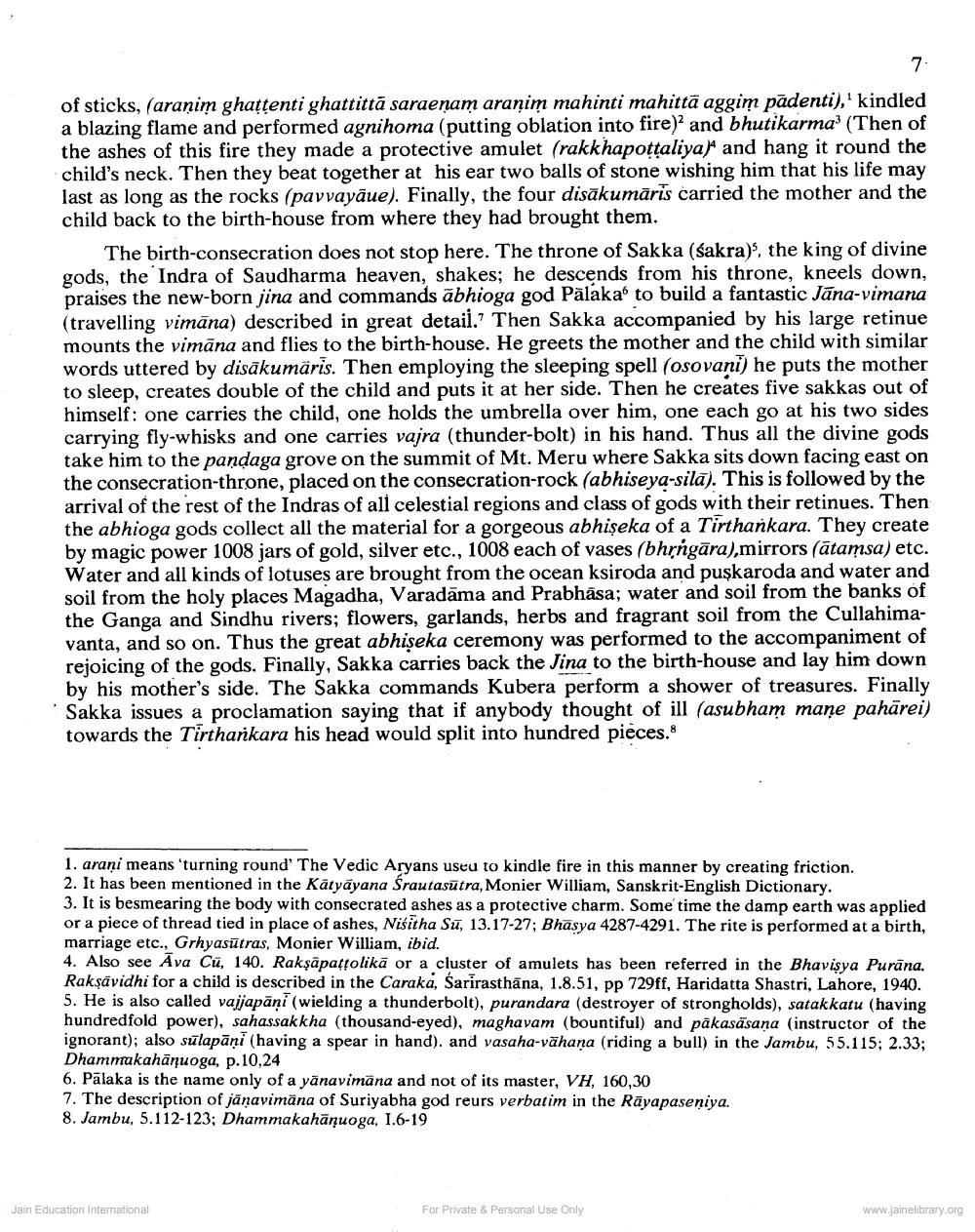________________
of sticks, (aranim ghattenti ghattittā saraenam aranim mahinti mahittā aggim padenti),' kindled a blazing flame and performed agnihoma (putting oblation into fire) and bhutikarma' (Then of the ashes of this fire they made a protective amulet (rakkhapottaliya)" and hang it round the child's neck. Then they beat together at his ear two balls of stone wishing him that his life may last as long as the rocks (pavvayāue). Finally, the four disākumāris carried the mother and the child back to the birth-house from where they had brought them.
The birth-consecration does not stop here. The throne of Sakka (šakra), the king of divine gods, the Indra of Saudharma heaven, shakes; he descends from his throne, kneels down, praises the new-born jina and commands ābhioga god Palaka to build a fantastic Jāna-vimana (travelling vimāna) described in great detail.' Then Sakka accompanied by his large retinue mounts the vimāna and flies to the birth-house. He greets the mother and the child with similar words uttered by disākumāris. Then employing the sleeping spell (osovani) he puts the mother to sleep, creates double of the child and puts it at her side. Then he creates five sakkas out of himself: one carries the child, one holds the umbrella over him, one each go at his two sides carrying fly-whisks and one carries vajra (thunder-bolt) in his hand. Thus all the divine gods take him to the pandaga grove on the summit of Mt. Meru where Sakka sits down facing east on the consecration-throne, placed on the consecration-rock (abhiseya-silā). This is followed by the arrival of the rest of the Indras of all celestial regions and class of gods with their retinues. Then the abhioga gods collect all the material for a gorgeous abhişeka of a Tirthankara. They create by magic power 1008 jars of gold, silver etc., 1008 each of vases (bhrngāra),mirrors (ātamsa) etc. Water and all kinds of lotuses are brought from the ocean ksiroda and puşkaroda and water and soil from the holy places Magadha, Varadāma and Prabhäsa; water and soil from the banks of the Ganga and Sindhu rivers; flowers, garlands, herbs and fragrant soil from the Cullahimavanta, and so on. Thus the great abhişeka ceremony was performed to the accompaniment of rejoicing of the gods. Finally, Sakka carries back the Jina to the birth-house and lay him down by his mother's side. The Sakka commands Kubera perform a shower of treasures. Finally Sakka issues a proclamation saying that if anybody thought of ill (asubham mane pahārei) towards the Tirtharkara his head would split into hundred pieces.
1. arani means 'turning round' The Vedic Aryans used to kindle fire in this manner by creating friction. 2. It has been mentioned in the Katyāyana Srautasūtra, Monier William, Sanskrit-English Dictionary. 3. It is besmearing the body with consecrated ashes as a protective charm. Some time the damp earth was applied or a piece of thread tied in place of ashes, Nišitha Sū, 13.17-27; Bhasya 4287-4291. The rite is performed at a birth, marriage etc., Grhyasūtras, Monier William, ibid. 4. Also see Ava Cü, 140. Raksāpattolikā or a cluster of amulets has been referred in the Bhavisya Purana. Raksävidhi for a child is described in the Caraka, Sarirasthāna, 1.8.51, pp 729ff, Haridatta Shastri, Lahore, 1940. 5. He is also called vajjapāņi (wielding a thunderbolt), purandara (destroyer of strongholds), satakkatu (having hundredfold power), sahassakkha (thousand-eyed), maghavam (bountiful) and pākasāsana (instructor of the ignorant); also sūlapāni (having a spear in hand). and vasaha-vähana (riding a bull) in the Jambu, 55.115; 2.33; Dhammtakahānuoga, p. 10,24 6. Pālaka is the name only of a yānavimana and not of its master, VH, 160,30 7. The description of jänavimăna of Suriyabha god reurs verbatim in the Rāyapaseniya. 8. Jambu, 5.112-123; Dhammakahānuoga, 16-19
Jain Education International
For Private & Personal Use Only
www.jainelibrary.org




